Role of Encounter Forms in Provider Records and Billing

On average, a doctor works around 51.4 hours a week, seeing around 11-20 patients a day. With these numbers, it’s challenging for hospitals to efficiently keep track of patient information without proper staff or encounter forms.
Comprehensive and organized medical records are the cornerstone of effective management of a healthcare facility and delivering high-quality care.
Encounter forms have become more crucial for billing ever since the digitization of medical records. Encounter forms systematically encapsulate information about billable treatments, making the medical billing process more seamless.
Keep reading to explore further the role of encounter forms in patient-provider relationships and billing.
What Is a Superbill or Encounter Form?
Encounter forms or superbills are documents containing comprehensive summaries of patient encounters, diagnoses and procedural codes, and treatments performed. In short, these forms withhold the insights of each interaction between a healthcare provider and a patient.
This standardized information streamlines the billing and reimbursement cycle through timely and accurate claim submission. Encounter forms also contain insurance and patient demographics.
Here are some things included in superbills.
- Basic patient information, including patient identification number.
- Demographic information like occupation and ethnicity.
- List of physicians assigned to the patient’s case.
- The reason behind the patient’s visit.
- Past medical history of the patient.
- Detailed information about the patient’s current illness, the onset, duration, and progression of the illness.
- The complexity of visits and assigned procedural and diagnosis codes.
- Staff and provider signatures indicating approval of the encounter form or superbill.

Examples of Encounter Forms
The layout and formats of encounter forms differ depending on the specific needs of the facility and the nature of the medical case. For example, dental care encounter forms include information like x-ray results, oral examination findings, dental history, treatment plans, and follow-up care.
Other examples of encounter forms include specialty-specific encounter forms, such as cardiology or neurology forms, gyne encounter forms, psychiatric encounter forms, pediatric superbills, and primary care encounter forms.
These examples will help you thoroughly understand what is an encounter form. It is crucial to record accurate information on superbills for effective treatment planning and preventing billing errors.
Importance of Encounter Forms In Billing
The information present in an encounter form is critical for multiple purposes. For instance, superbills enhance communication and collaboration among the healthcare staff as well as between the patient and provider.
With essential information regarding the patient’s condition being readily available, any changes in the treatment plans and further specialist recommendations can be conveyed easily.
Comprehensive documentation, such as patient encounter forms, allows healthcare organizations to maintain consistent and thorough patient records.
Information relevant to reimbursement and billing is also included in medical encounter forms. The standardized format used in patient encounter forms makes it easier to record medical diagnoses and services and translate them into codes. This contributes to coding compliance.
Due to encounter forms, claims can be submitted on time, preventing delayed or denied reimbursements. These documented records also assist healthcare facilities in legal inquiries and audits and ensure the facility is compliant with healthcare regulations.
All facilities use electronic encounter forms for their patients because manually filling in the form and adding signatures to approve each form increases the administrative burden on the hospital’s staff.
With digitized encounter forms or superbills, providers have more time to focus on providing high-quality care to their patients. Another way encounter forms improve the quality of patient care is by allowing providers to identify and eliminate any negative patterns and outcomes documented in previous forms.
Hospitals can encounter liability issues now and then, and without detailed records of patient encounters, it can be difficult to mitigate the risk of legal penalties. With complete information on recommendations made and treatments administered to the patient, providers and healthcare facilities can avoid potential liability claims.
FAQs
What are the key components of Superbills/ Encounter Forms in medical billing?
The content recorded in superbills or encounter forms can differ by each patient encounter, but some key components of these forms include ICD-10 and CPT codes, modifiers, tracking units of services, patient demographics, medical history, breakdown of services provided to patients, and provider details.
Information needed on a comprehensive Superbills includes?
If you’re wondering in what format a superbill comes, you should know that comprehensive superbills include insurance coverage information, patient instructions, fee schedules, and quantity and units or rendered procedures, along with basic patient information, medical history, translation of services into billable codes, and provider information.
4 Examples of Superbills in Healthcare?
Superbills are defined as detailed invoices outlining services rendered to patients. There are different types of superbills detailing specific information. Some examples of superbills include dermatology and dermatology practices. These superbills include dermatologic procedures, dates of service, patient data, and any corresponding codes. Other examples include primary care superbill, orthopedic superbill, and gynecology superbill.
